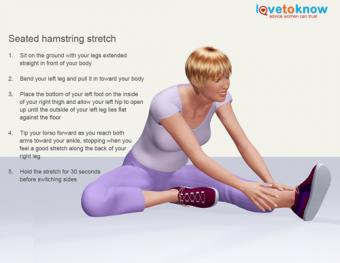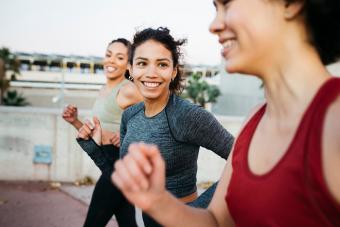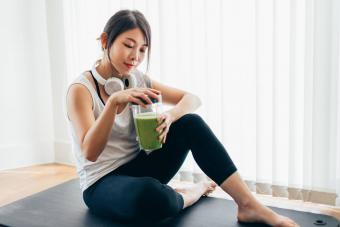
Maintaining flexibility throughout life is a key component of functional fitness. If you fail to stretch regularly, your muscles will grow tight, your range of motion will be limited and you'll find it more difficult to move around comfortably. Eventually, this can lead to trips, falls and broken bones, all of which can limit your quality of life. The good news is that it doesn't take much to maintain and enhance flexibility. Perform the following stretching routine two to three times a week using these 11 full-body stretching exercises. The entire routine shouldn't take more than 15 minutes, and with continued performance, the results can last a lifetime.
11 Free Stretching Exercises
A stretching routine should flow naturally, starting with standing exercises, slowly moving to kneeling, then seated exercises. You should perform each stretch to the point of slight discomfort, but you should never feel outright pain. Understand that everyone's flexibility is different, so it may be beneficial to use a yoga block, yoga strap or exercise towel to help you perform stretches that are more difficult. For instance, to perform the Seated Hamstring Stretch detailed below, you could wrap a towel around the bottom of your foot, grasping the ends with both hands. You would then be able to use the towel to pull yourself into a stretch that feels comfortable without having to reach all the way to your ankles. Play with these accessories as needed to enhance your flexibility routine.
To get more details on each of the exercises, please click on the image thumbnail to download and print the file. If you need help downloading any of the printables, check out these helpful tips.
Overhead Triceps Stretch

The overhead triceps stretch will target the back of your upper arm. The tricpes muscles make up the majority of muscle mass of your arms, so it's very important to stretch these muscles thoroughly. With your arms extended over your head, pull one elbow with your opposite hand, reaching as far down your spine as you comfortably can.
Cross-Body Shoulder Stretch

You'll feel the cross-body shoulder stretch targeting the back of your shoulder as well as your upper back. To perform this stretch, pull one arm across your body, grasping it with your opposite hand, just above your elbow. Pull it into your body and across your chest to deepen the stretch.
Wall-Assisted Chest, Shoulder and Biceps Stretch

Just like the title says, the wall-assisted chest, shoulder and biceps stretch will target your chest, shoulder and biceps. To perform this stretch, use a wall, or another sturdy object, like a column or heavy piece of exercise equipment, to stretch your arm behind you, parallel to the floor. Move closer to the wall or sturdy object to deepen the stretch.
Standing Quadriceps Stretch

The standing quadricpes stretch will stretch the front of your thigh. To perform the stretch, grasp one ankle with your hand from the same side of your body, pulling your foot toward your buttocks until you feel a strong pull. Avoid the urge to lean forward or backward while performing the stretch. If you need help maintaining your balance, place your opposite hand on a sturdy object, like a wall or the back of a chair.
Wall-Assisted Calf Stretch

You'll feel the calf stretch along the back of your lower leg, into your ankle and heel. Use a wall to stretch your calf muscles. You can perform this stretch one of two ways: as shown on the printable, or by stretching one leg out behind you as you lean into the wall, keeping your heel on the floor and your leg straight. When performed this way, you'll feel the stretch on the extended calf, while your opposite leg remains bent to help you maintain your balance.
Kneeling Hip Flexor Stretch

Your hip flexors run along the front of your hip, between your torso and quadriceps, so you'll feel this stretch along the front of your hip and the top of your thigh. You may perform this stretch kneeling or standing, but it's often easier to "find" the stretch when performing it in the kneeling position. The key here is to press forward with your hips, shifting your weight into your front leg without bending forward at the hips or waist.
Seated Hamstring Stretch

Your hamstrings run along the back of your thigh, and they tend to become quite tight if not stretched regularly. This tightness often leads to back pain. When you perform this stretch, you will feel it along the back of your thigh, up into your glutes, and you may feel a slight pull in your lower back. Move into this stretch slowly and steadily to avoid pulling a muscle. Be sure to tip forward from the hip, rather than leaning forward from the waist. You want to keep your back as straight as possible during this stretch.
Butterfly Adductor Stretch

Your adductors are a very strong group of muscles running down your inner thigh, between your groin and your knee. When performing the butterfly stretch, you'll feel the stretch on your inner thigh. Just make sure you don't "flutter the butterfly wings" by bouncing your legs up and down. Lots of people grew up performing the butterfly stretch with this ballistic stretching approach, but if you're just starting up a stretching routine again, ballistic stretching could cause injury. Find the proper position, then hold yourself in place, slowly deepening the stretch as you can.
Seated Hip and Torso Stretch

It's easy to forget that the "core" muscles of your back, abdominals and hips need to be stretched, especially given how much time is spent hunching over computers these days. The seated hip and torso stretch will target your obliques, abs, lower back and abductors (the muscles that run along the outside of your hip and thigh).
Lying Abductor Stretch

Another common culprit when it comes to back pain are tight abductors. The abductors are a group of muscles that run along the outside of the thigh that are responsible for lateral rotation and abduction (external movement) of your thigh. You'll feel the abductor stretch in your glutes and along the outside of your upper leg. Don't be surprised if this one's tough! Tight abductors are an issue that many Americans deal with, and this stretch can be one of the most helpful when it comes to alleviating back pain.
Cobra Torso and Chest Stretch

The cobra torso and chest stretch is one of those functional stretches that helps counter-balance the tightness that can occur from spending too much time in front of a computer screen. Instead of hunching forward with your abs, chest and shoulders all crunching in, the cobra forces you to open up the hips, abs, chest and shoulders while hyperextending your back. Not only is this a great stretch to improve posture, it can also help relieve stress and remind you to breathe.
Changing Up Your Routine
After a few weeks or months, you may discover that your flexibility has improved and your routine is beginning to stagnate. There are hundreds of stretches you can perform to keep seeing results. Talk to a trainer at your gym to get a few ideas, or consider taking a yoga or stretching class. Generally speaking, stretching is intuitive, so try moving around to see what poses target the muscles where you're feeling tightness. Just remember: a nice stretch is good, but pain is bad. Don't do anything that might cross the line between stretching and personal injury.







